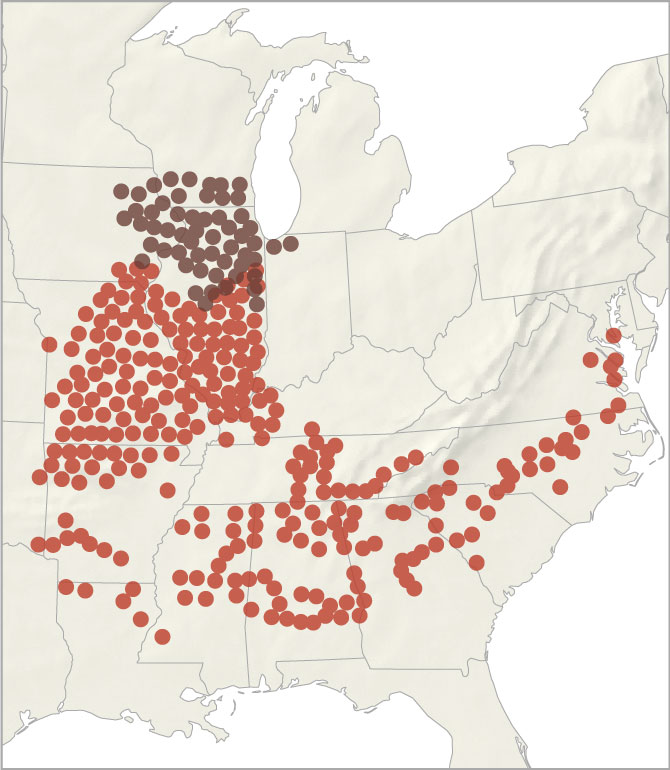Sammy Ramsey casts the mass emergence of the big, red-eyed bugs as a love story, not an insect apocalypse.
Spring has sprung, and coming with it is a mass emergence of two broods of cicadas. After more than a decade underground, they will tunnel through the soil and up to the treetops to spend the remainder of their lives loudly buzzing for a mate.
In some places, people have already spotted the insects — or, at least, heard their call.
Sammy Ramsey, an entomologist at the University of Colorado Boulder, says he feels like these bugs get a bad rap. To combat that, he uploaded a silly, but surprisingly smooth, music video to YouTube during the emergence of an earlier cicada brood in 2021. He hoped that the song, called “Big Red Eyes,” would help people empathize with the isolation cicadas endure for most of their lives, especially given our seclusion during the early phases of the pandemic.
Since then, Dr. Ramsey has been on a mission to change people’s perception of cicadas. He’s traveling to Illinois — the one place where some of the two emerging broods are expected to overlap — to film the insects emerging from the soil. Dr. Ramsey recently spoke with The New York Times about the behavior of these creatures, and why we should revere rather than fear them.
The following conversation has been lightly edited for clarity.
I hear cicadas every summer. Why the sudden craze?
That’s the annual, or dog-day, cicada, which typically have green wings. Annual cicadas do not have the periodicity of the magicicada that are emerging soon.
Two Cicada Broods
Cicadas are expected to emerge across a wide swath of the Midwest and Southwest this spring.
#g-map-box ,
#g-map-box .g-artboard {
margin:0 auto;
}
#g-map-box p {
margin:0;
}
#g-map-box .g-aiAbs {
position:absolute;
}
#g-map-box .g-aiImg {
position:absolute;
top:0;
display:block;
width:100% !important;
}
#g-map-box .g-aiSymbol {
position: absolute;
box-sizing: border-box;
}
#g-map-box .g-aiPointText p { white-space: nowrap; }
#g-map-335 {
position:relative;
overflow:hidden;
}
#g-map-335 p {
font-family:nyt-franklin,arial,helvetica,sans-serif;
font-weight:300;
line-height:10px;
height:auto;
opacity:1;
letter-spacing:0.16em;
font-size:9px;
text-align:left;
color:rgb(0,0,0);
top:0.7px;
position:static;
text-transform:none;
padding-bottom:0;
padding-top:0;
mix-blend-mode:normal;
font-style:normal;
}
#g-map-335 .g-pstyle0 {
height:10px;
text-align:center;
position:relative;
}
#g-map-335 .g-pstyle1 {
font-weight:700;
line-height:16px;
height:16px;
letter-spacing:0em;
font-size:14px;
text-align:center;
color:rgb(113,42,24);
top:1.1px;
position:relative;
}
#g-map-335 .g-pstyle2 {
line-height:16px;
height:16px;
letter-spacing:0em;
font-size:14px;
text-align:center;
color:rgb(113,42,24);
top:1.1px;
position:relative;
}
#g-map-335 .g-pstyle3 {
font-weight:700;
line-height:16px;
height:16px;
letter-spacing:0em;
font-size:14px;
text-align:center;
color:rgb(186,71,51);
top:1.1px;
position:relative;
}
#g-map-335 .g-pstyle4 {
line-height:16px;
height:16px;
letter-spacing:0em;
font-size:14px;
text-align:center;
color:rgb(186,71,51);
top:1.1px;
position:relative;
}
MINN.
Brood XIII
17-year cicadas
N.Y.
MICH.
IOWA
PA.
ILL.
OHIO
MO.
MD.
IND.
W.VA.
VA.
KY.
N.C.
TENN.
ARK.
GA.
S.C.
ALA.
Brood XIX
13-year cicadas
MISS.
LA.
